Call it a Cashmere scarf, or call it luxury personified, these beauties deserve a place in every art lover's luxury wardrobe. Soft, warm, and exceptionally graceful, these ethereal accessories are something that keeps you warm as well as stylish, on freezing winter days, when all you want to do is hide under blankets.
Cashmere scarves are not just accessories; they are expressions of luxury, comfort, and timeless elegance. From their origins in the Kashmir region to their meticulous production and care, these scarves embody the essence of fine craftsmanship. Whether draped casually for a stroll in the park or elegantly wrapped for a formal event, cashmere scarves add an unmatched level of sophistication to your attire. With proper care, they can become cherished companions for years, keeping you warm and stylish in all seasons. So, embrace the luxurious comfort and elegance of cashmere scarves, and let them become an essential part of your fashion journey.
A Cashmere scarf instantly lifts your outfits up, when they look basic or ‘like any other day’. These have the power to transform even the plainest looks into classic and stylish ones in an instant. Stylish, as ever, women can wear Cashmere scarves in a number of ways, and all of those look classy and sophisticated.
What is a Cashmere Scarf?
Cashmere scarves, renowned for their unparalleled softness, warmth, and elegance, hold a special place in the world of fashion and luxury. Derived from the fine undercoat of Cashmere goats, these scarves are prized for their quality and timeless appeal. In this blog, we will delve into the world of cashmere scarves, exploring their origins, production, care, and styling options. We will know why patrons consider Cashmere scarves an essential accessory, especially those seeking both comfort and sophistication.
The Origin and Production of Cashmere Scarves
Cashmere scarves, renowned for their unparalleled softness and luxurious warmth, have a rich and storied history that traces its origins to the rugged terrain of the Himalayan region. These exquisite accessories have evolved over centuries, from humble beginnings to becoming coveted fashion items. The story of cashmere scarves begins with the extraordinary Cashmere goat, known for its fine, insulating undercoat. These goats are native to the high-altitude regions of the Kashmir Valley in northern India, as well as parts of Nepal and Tibet.
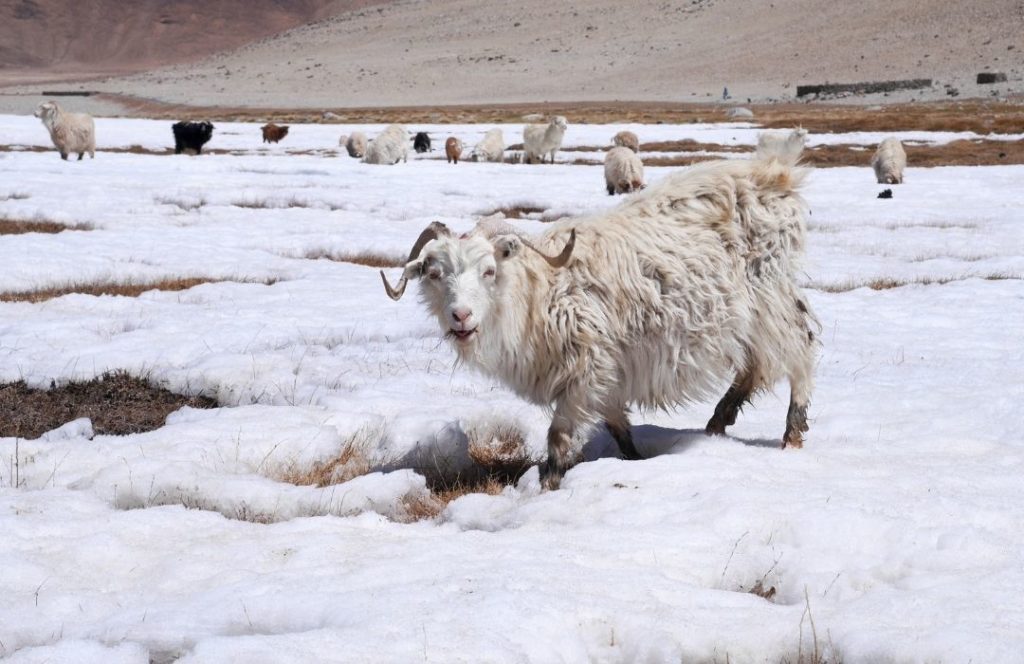
The harsh climates in these areas have driven the evolution of Cashmere goats, resulting in the development of a soft and incredibly warm undercoat, which provides essential protection against extreme cold. One can trace back the use of cashmere fibres for textiles over a thousand years in the Kashmir region. Local artisans and weavers began crafting textiles, including shawls and scarves, from the luxurious cashmere wool. This early craftsmanship laid the foundation for what would become a global sensation in the world of fashion.
Exporting the popular fibre
In the 14th century, cashmere textiles began making their way to Europe, carried along the trade routes that connected the East and West. These sumptuous shawls and scarves captured the imagination of European nobility and quickly gained a reputation for their softness, warmth, and intricate designs. The cashmere shawl, in particular, became a status symbol among European aristocrats.
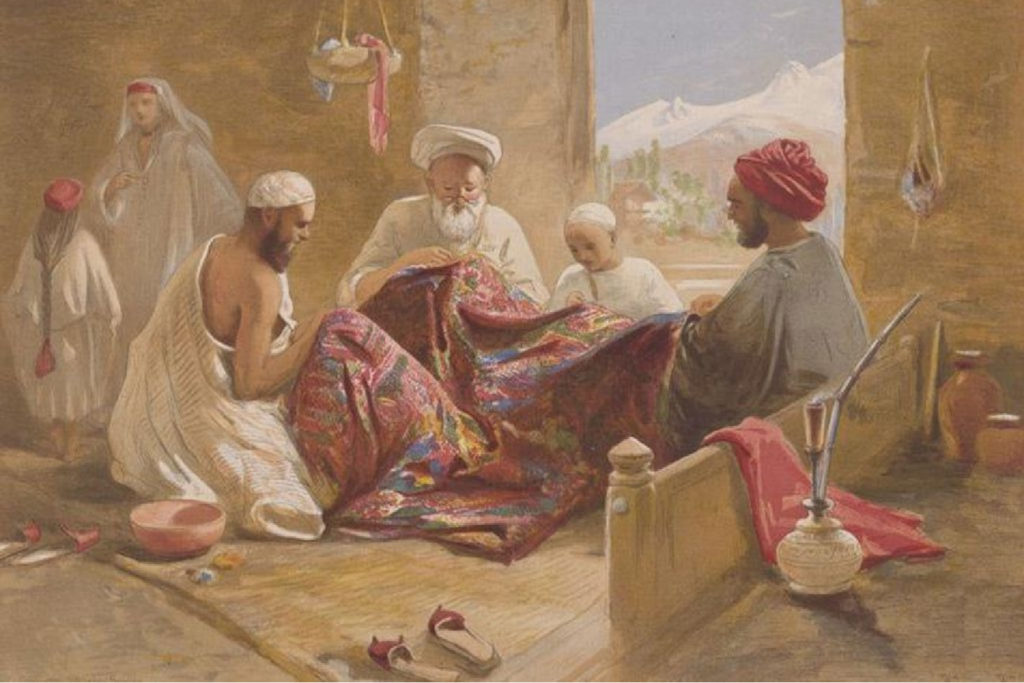
The popularity of cashmere scarves continued to grow throughout the 18th and 19th centuries. European textile mills sought to replicate the fine craftsmanship of Kashmiri weavers, leading to innovations in production techniques. By this time, cashmere scarves were the most famous luxury items and were particularly fashionable among European elites.
Production in Europe
The mid-19th century marked a significant shift in the production of cashmere scarves. European manufacturers began using mechanical looms to mass-produce cashmere textiles, making them more accessible to a broader market. This shift in production also led to the creation of new styles and patterns, catering to changing fashion tastes.
Cashmere scarves found their way into the wardrobes of iconic figures throughout history. In the early 20th century, Coco Chanel famously embraced cashmere as a symbol of modernity and luxury. Her designs, including cashmere scarves, revolutionized fashion and brought cashmere to the forefront of high-end couture.
Today, cashmere scarves remain highly regarded for their quality and timeless appeal. While traditional craftsmanship continues in the Kashmir region, modern technology has also influenced production methods. Cashmere scarves are now produced not only in India but also in other parts of the world, including Mongolia, China, and Scotland, each with its unique approach and expertise in crafting these exquisite accessories.
Harvesting Cashmere Fibres
Harvesting cashmere fibres is a delicate and labour-intensive process that requires skill and precision. Workers obtain these fine, luxurious fibres from the undercoat of Cashmere goats, particularly during the spring molting season when the goats naturally shed their winter fur. Here's a closer look at the process of harvesting cashmere fibres:
Timing the Harvest
The prime time for harvesting cashmere fibres occurs during the spring when the Cashmere goats naturally begin to shed their thick winter coats. This molting process typically starts in March or April when the weather begins to warm up and the goats no longer need the insulation provided by their winter fur.
Combing or Shearing

There are two main methods for harvesting cashmere fibres: combing and shearing.
- Combing: This traditional method involves gently combing the goats' undercoat to remove the loose fibres. Skilled herders use specialized combs with fine teeth to separate the soft cashmere fibres from the coarser guard hairs. This process is time-consuming but minimizes the risk of damaging the valuable cashmere fibres.
- Shearing: In some cases, especially when herders need to deal with large herds efficiently, they shear Cashmere goats similar to how they shear sheep for their wool. Shearing involves using electric clippers to remove the entire coat, both the cashmere undercoat and the guard hairs. While this method is quicker, it requires more careful sorting and processing to separate the cashmere fibres from the coarser hairs.
Sorting and Selecting
Once herders collect the cashmere fibres, they go through a meticulous sorting process. This step involves:
- Removal of Impurities: Workers remove any dirt, dust, or vegetable matter that adheres to the fibres during the collection process.
- Colouur Separation: Cashmere fibres come in various natural colors, including white, gray, and brown. Workers often sort the fibres by colour to create uniform batches.
- Fineness Grading: Cashmere fibres vary in fineness, with the softest and finest fibres being the most coveted. Sorting involves grading the fibres by their diameter and quality.
Cleaning and Processing
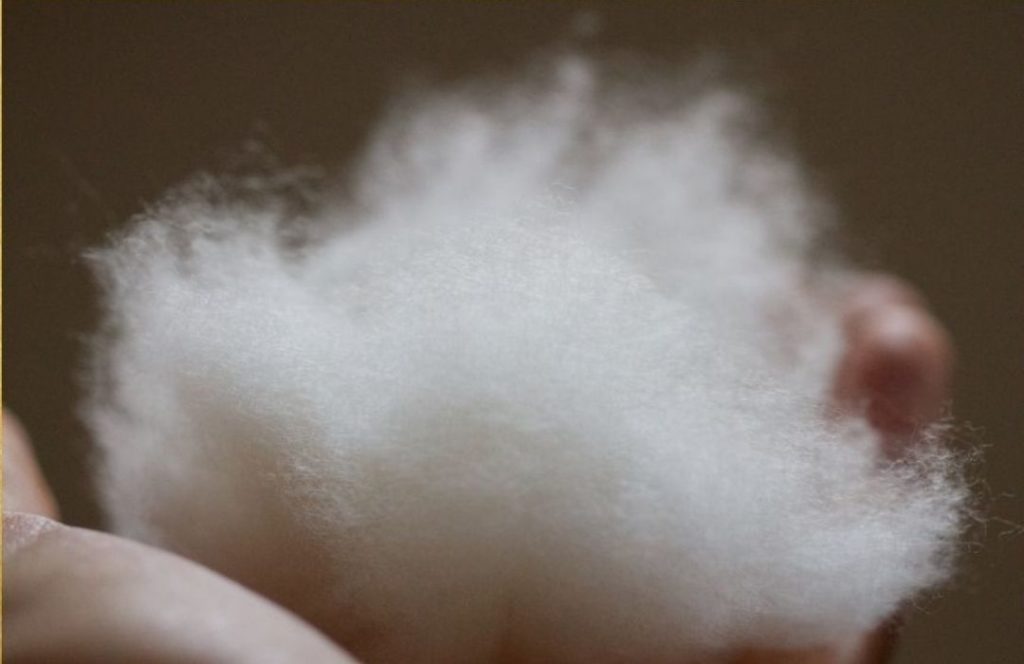
After sorting, workers clean the cashmere fibres to remove any remaining impurities. Workers typically do this through a gentle washing process that uses a mild detergent specially designed for delicate fabrics. The fibres are then carded, a process that aligns the fibres in the same direction, preparing them for spinning into yarn.
Spinning into Yarn
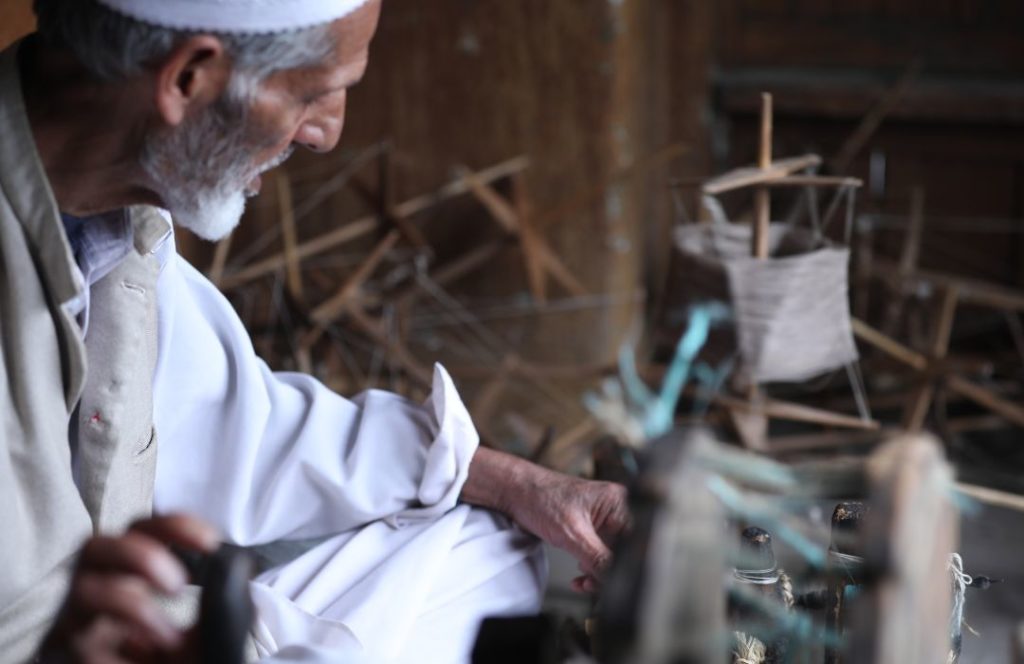
Artisans spin Cashmere fibres into fine yarns using various spinning techniques. The resulting cashmere yarn is incredibly soft, lightweight, and luxurious, making it ideal for creating cashmere scarves and other high-quality garments
Raw Cashmere is spun on the traditional spinning wheels which is called "Yinder" in the local language. Women artisans work on these spinning wheels. Undoubtedly, these are exceptionally skilled and experienced in the same. With the perfect coordination between two hands, these women transform lumps of Cashmere wool into fine fibres. These fibres are just 12 to 15 microns in thickness, and hence extremely lightweight yet warm. Women artisans now hand these over to men, who take the fibres for weaving.
Weaving Scarves
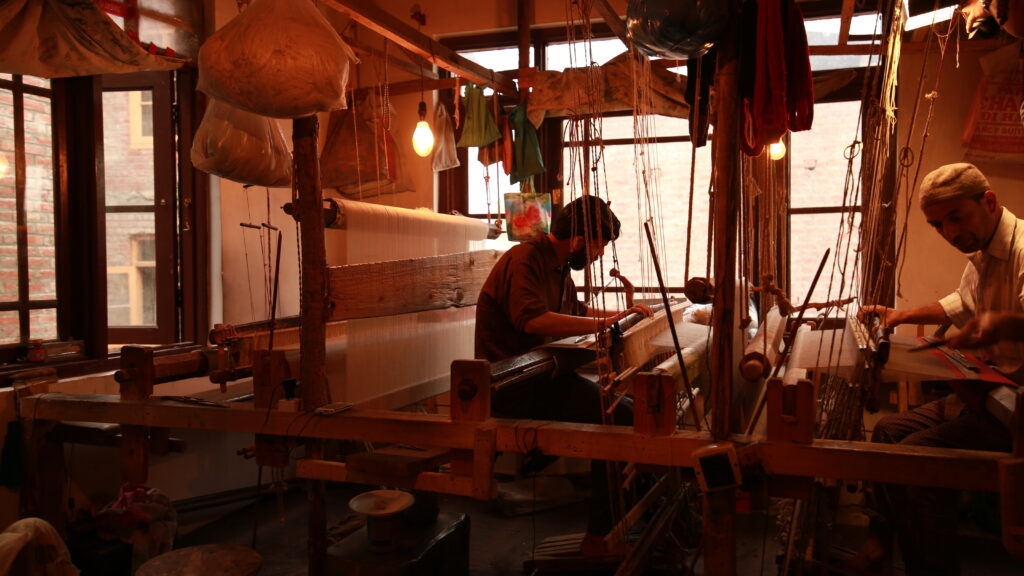
Cashmere scarves are usually handwoven to maintain the delicate nature of the fibres. Expert craftsmen use traditional techniques to create scarves of various styles, from classic solids to intricate patterns. The weaving process allows for the creation of lightweight, warm, and incredibly soft scarves.
It is the traditional wooden handloom that men use to hand weave Cashmere scarves. Two men sit on the opposite sides of the loom and start weaving the scarf. It takes about 3 to 4 days to weave a large scarf.
Finishing Processes
- Washing: The freshly woven Cashmere scarf undergoes a thorough washing process to remove any impurities, excess dye, and natural oils. This step is crucial to ensure the shawl's purity and softness.
- Mild detergents and cold water are typically used in the washing process
- Rinsing and Soaking: After washing, the scarf is rinsed multiple times to remove all traces of detergent and to restore its natural softness.
- Stretching and Drying: The wet scarf is then carefully stretched to its desired dimensions. This step helps maintain the scarf's shape and prevents shrinkage during drying.
- Pressing and Ironing: Once the scarf is completely dry, it is lightly pressed and ironed to smoothen out any wrinkles and achieve a uniform texture.
- Fringing: Artisans fringe the edges of the Cashmere scarf by hand. Artisans carefully knot and trim the fringes to ensure they are even and neat.
- Embroidery and other embellishments: Some scarves receive additional embellishments or embroidery as per the design and style specifications.
Evolution of Cashmere scarves
When Cashmere was discovered in the 15th century in Kashmir, the very first product made with it was a pair of socks for the then-king. Later, when processing units were set up for the same, Cashmere would be transformed into scarves, wraps, and apparel.
The first scarves were plain. Then gradually, artisans began to embroider it with their own hands. This was the start of Cashmere embellishments. Later came the Kani weave which created an uproar in the world of Cashmere. Europeans, especially, were swooned by this design. Later, they began to export thousands of the same. People consider all these traditional designs, timeless and beautiful. But soon, fashion changed and fresh patterns entered the market. The younger generation did not prefer to wear profusely embroidered scarves or Kani woven wraps, and hence the demand abated much.
Artisans realized this and adapted to new patterns. Now Cashmere scarves feature animal prints, floral prints, laces, stripes, tartan checks, and much more. From middle-aged women to teenage girls to elderly ladies, all could have their choice of Cashmere scarves, which would look perfect for their age.
Why choose Cashmere?

When the chill of winter descends, the choice of fabric for your cold-weather wardrobe is crucial. Among the various options available, cashmere stands out as the epitome of luxury and comfort. Here are some reasons why women prefer to wear Cashmere than any other winter fabrics available:
Unmatched softness
Cashmere fibres are popular for their extraordinary softness. They are exceptionally fine and delicate, measuring only about 12-15 microns in diameter. This makes cashmere one of the softest natural fibres in the world. When you wear a cashmere garment, you experience a level of comfort and gentleness against the skin. And certainly, this is unmatched by other fabrics
Immense Warmth and Insulation
Despite its lightweight nature, cashmere is highly effective at retaining heat. The fine fibres create air pockets that trap warmth close to the body, providing excellent insulation against the cold. This natural insulating property keeps you warm and cozy without the bulk associated with some other winter fabrics. Cashmere's ability to regulate body temperature sets it apart from other materials. It adapts to your body's needs, keeping you warm in chilly conditions and preventing overheating in milder weather
Breathability
Cashmere is a natural fibre with excellent breathability. It can wick moisture away from the body, preventing that clammy feeling often associated with synthetic materials. This breathability ensures comfort in a variety of climates, making cashmere an excellent choice for both cold and milder winter days
Longevity and Durability
When cared for properly, cashmere garments can last for many years. The long, fine fibres are less prone to pilling than other materials, and their natural elasticity helps the fabric retain its shape over time. Choosing cashmere is not only a statement of luxury but also an investment in a durable and enduring wardrobe piece
Timelessness
Cashmere exudes timeless elegance and sophistication. Whether you opt for a classic cashmere sweater, scarf, or coat, you instantly elevate your outfit. The understated luxury of cashmere adds an element of refinement to both casual and formal ensembles.
Ethical and Sustainable
Opting for ethically sourced cashmere supports responsible practices in the fashion industry. Ethical producers prioritize the well-being of Cashmere goats and the livelihoods of local communities involved in the production process. Sustainable cashmere production focuses on maintaining the health of Cashmere goat herds, preserving natural ecosystems, and minimizing environmental impact.
Slow Fashion, long-term benefits
While cashmere may come with a higher price tag compared to some other winter fabrics, it offers long-term value. The exceptional quality and durability of cashmere mean that your investment will continue to provide comfort and style for years to come. Choosing cashmere over cheaper, mass-produced alternatives contributes to a reduction in the demand for fast fashion. It aligns with the trend toward more conscious and sustainable consumption practices.
Styling a Cashmere scarf
Often owners of Cashmere scarves ask us questions about the styling of Cashmere scarves. Furthermore, women and men are fed up with tying the same good old French knots, or classic loops. They want to do something new to their luxury scarves which would look amazing, as well as keep them warm and comfortable all day long. So we just discovered a list of exclusive styles to wrap a Cashmere scarf in ‘one of a kind’ ways. Get inspired by these classy looks and find yourself looking fresh and gorgeously different.
Also read: CAN YOU WEAR CASHMERE EVERYDAY?
Different Styles to wear a Cashmere scarf
Winter is already upon us. And even though we have a large number of winter fabrics, patrons often choose Cashmere for the myriads of benefits it gives. And without a doubt, winter is the best time to get inspired by these classic styles of wearing a Cashmere scarf. Whether you choose to wear your Cashmere this way or create your own styles, Cashmere is versatile enough to adapt to all.
Style 1: The Snood Style Cashmere scarf
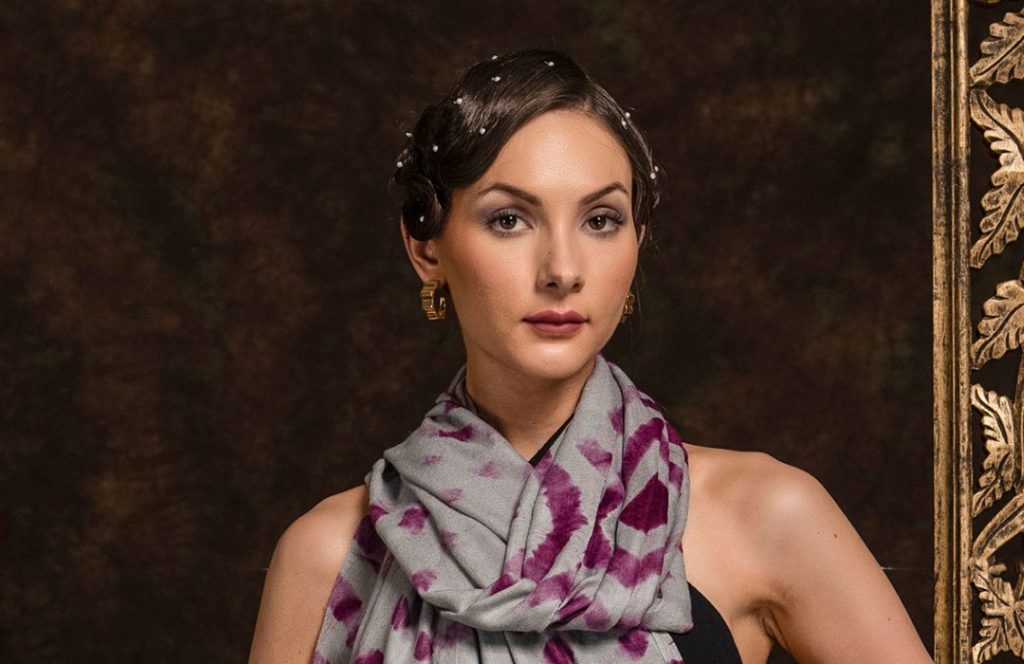
Wrap the scarf in such a way that one of the ends remains exactly below your collarbone. Now wrap the loose end around your neck till it reaches the end. Following, tuck both ends into this doubled loop that you just created around your neck. You can even fluff the wrap according to your liking. Fluffing can create a high or low height and cover the area that you want.
Style 2: The Waterfall Style Cashmere scarf
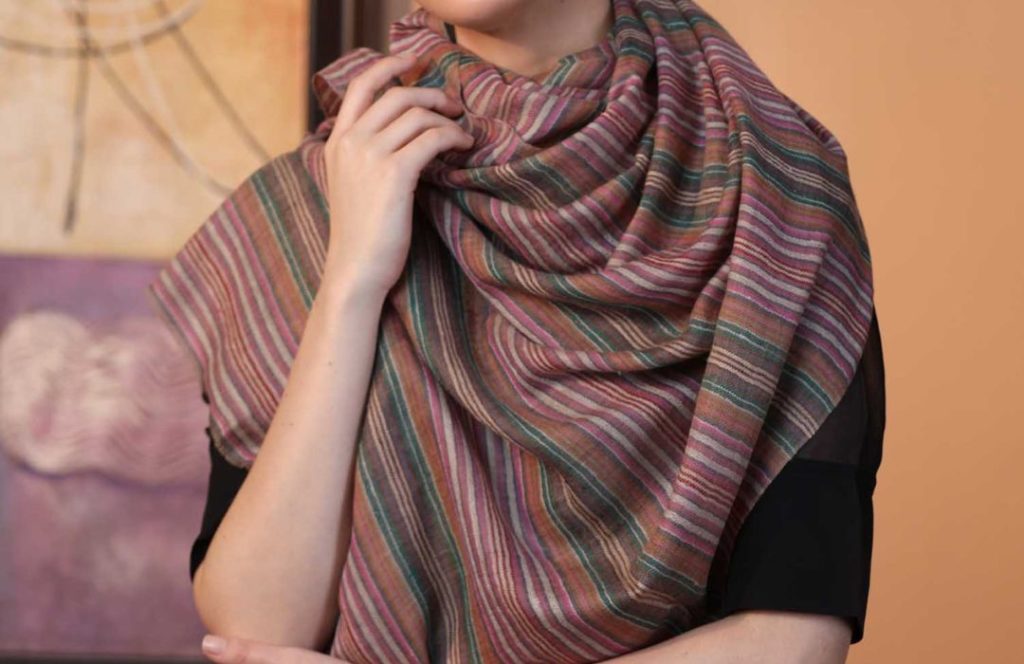
One of the most unique styles of wearing your Cashmere scarf is definitely the waterfall look. Firstly, loop your scarf around your neck, with one end left around your mid-chest level. Now take the longer end, and pull it through the original loop created at the neck. Simultaneously pull the end through, leaving it hanging in folds across your chest. You are done for an evening out with friends or family.
Style 3: The Fling Style
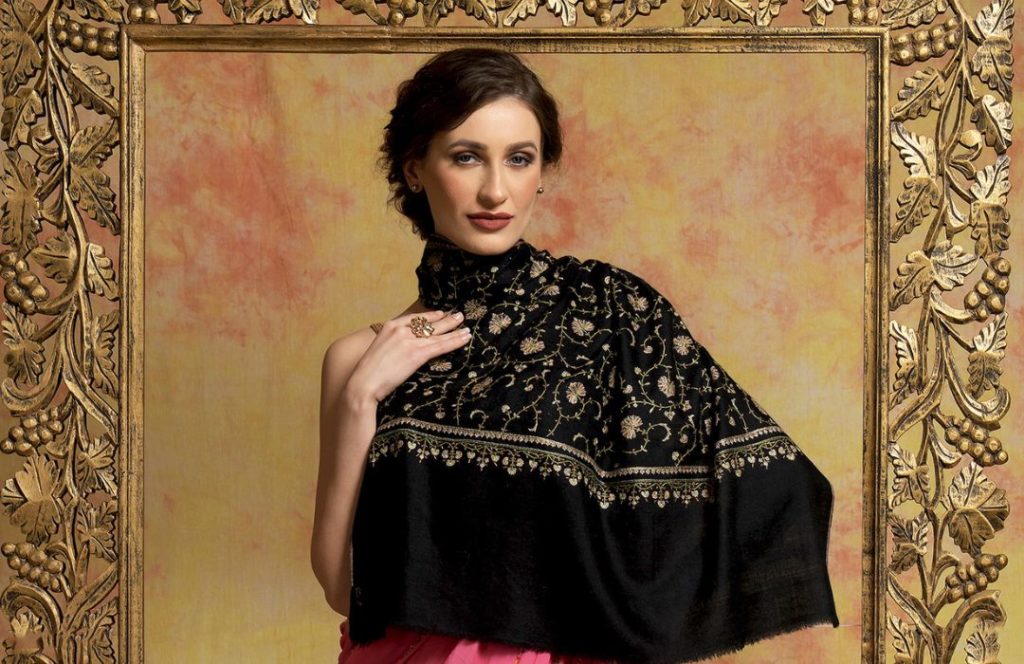
Perhaps the easiest of them all is the fling style, which covers the upper body and makes sure you feel comfortable besides looking stylish. Start by placing one end of the scarf over your left shoulder. Take the right end and twist it near your right shoulder. Fling this side over the left shoulder. This scarf style will look like a cape and cover your body in its pleasing warmth. This style can be adopted if your scarf has a flaunt-worthy print or embroidery over it.
These are some unique and exclusive styles that you can style your Cashmere scarves in. Choose your scarf wisely. It is better to use solid and patterned scarves in styles where the scarf remains folded or hidden. Hand-embroidered scarves, which host full embroidery all over the scarf should be worn in styles that showcase maximum base.
Style 4: The Shawl Style

On particularly chilly days, you can wear your cashmere scarf like a shawl. Open it fully and drape it over your shoulders. This style not only keeps you warm but also adds an element of elegance to your outfit. It pairs well with dresses and coats. Women often choose the Shawl style with scarves that have embroidery or Kani weave on them. It is to display the intricate embellishments as well as stay cozy and comfy.
Style 5: The Belted Style Cashmere scarf
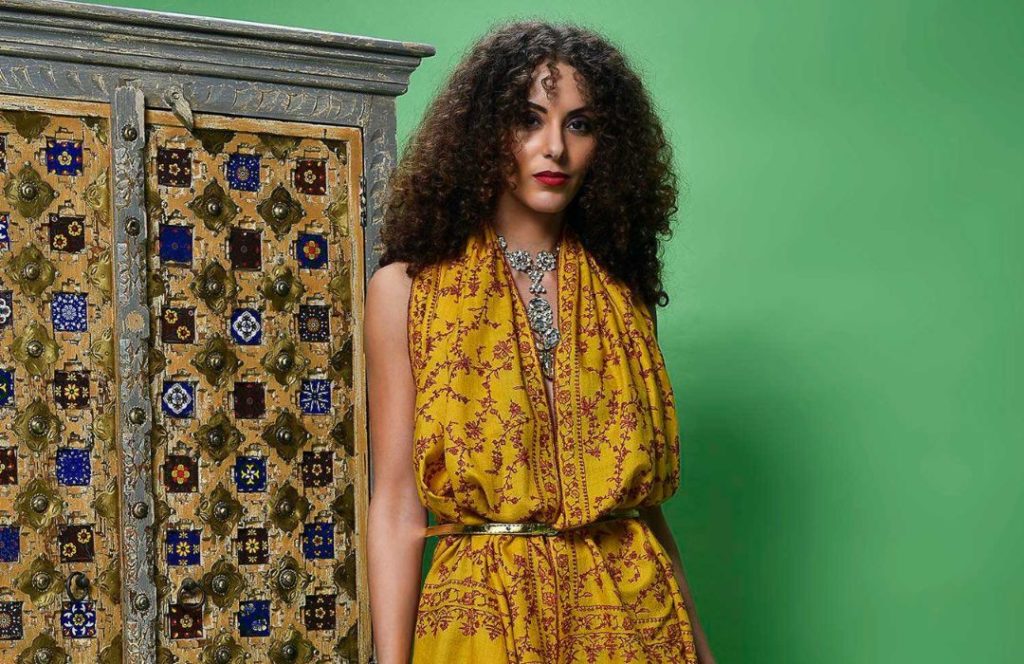
Transform your cashmere scarf into a stylish belted shawl. Drape it over your shoulders like a shawl and cinch it at the waist with a belt. This creates a chic and cozy look, ideal for both casual and formal occasions. You can adorn this belted Cashmere scarf with brooches and pins to make it look more exclusive. This style looks good when paired with western wear like jeans and skirts.
Style 6: The Loose Loop

Achieve a cozy and relaxed look by loosely looping your cashmere scarf around your neck multiple times. This style is perfect for casual winter outings and adds a layer of warmth. It looks super cool when paired with your favourite pair of jeans and tops.
Also read: WHAT SCARVES ARE IN STYLE FOR 2023?
Concluding
In the world of winter fabrics, cashmere reigns supreme for its unbeatable softness, superior warmth, and enduring elegance. Its versatility, ethical sourcing options, and sustainability make it a choice that aligns with both personal comfort and responsible fashion choices. When you choose cashmere, you're not merely selecting a fabric; you're embracing a tradition of luxury and quality that goes beyond seasonal trends. Cashmere garments are not just for winter; they are timeless investments in comfort, style, and ethical fashion.
Wearing a cashmere scarf is not just about bundling up for the cold; it's an art form that allows you to express your style and elevate your look. Whether you opt for the classic drape, the Parisian knot, the loose loop, the shawl wrap, or the belted shawl, your cashmere scarf can transform your outfit into a statement of elegance and warmth. The versatility of cashmere knows no bounds, as it seamlessly transitions from casual to formal, from winter to spring. So, embrace the softness, warmth, and luxury of your cashmere scarf, and let it become an essential accessory in your fashion repertoire. Remember, it's not just about staying cozy; it's about making a statement, one knot or drape at a time.